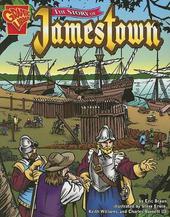
|
Story of Jamestown
Paperback / softback
Main Details
| Title |
Story of Jamestown
|
| Authors and Contributors |
By (author) ,Eric Braun
|
| Physical Properties |
| Format:Paperback / softback | | Pages:32 |
|
| ISBN/Barcode |
9780736862103
|
| Classifications | Dewey:975.54251 |
|---|
| Audience | |
|---|
| Illustrations |
Illustrations, unspecified; Illustrations, unspecified
|
|
Publishing Details |
| Publisher |
Capstone Press
|
| Imprint |
Capstone Press
|
| Publication Date |
1 January 2006 |
| Publication Country |
United States
|
Description
Tells the story of Jamestown, the first permanent English settlement in North America. Written in graphic-novel format.
Author Biography
Eric Braun is a children's author and editor. He has written dozens of books on many topics, and one of his books was read by an astronaut on the International Space Station for kids on Earth to watch. Eric lives in Minneapolis with his wife, two kids, and a dog who is afraid of cardboard. Steve originally hails from Oklahoma, and is a 2007 inductee into the Oklahoma Cartoonist Hall of Fame. He spent over a decade penciling comic books for DC Comics. Over the years, he's lent his artistic talents to a variety of other fields, ranging from t-shirt design to spot illustration to kids meal toys. He resides in north Texas where he makes a nice living as a product illustrator and designer for seasonal decorative items, occasionally dabbling in comics art and graphic novels. His wide range of experience falls in line with his personal philosophy as summed up by author Douglas Adams: I seldom end up where I wanted to go, but almost always end up where I need to be.
ReviewsIn the 1500s Spain and Portugal acquired large tracts of land and great wealth in South America. England was jealous of their successes so the king of England sent out expeditions to North America to see if colonies could be founded in that land. In 1606, King James gave the London Company permission to settle a new colony in an area which would later be called Virginia. Three ships set off in December and when they arrived in America, the travelers explored the area around the Chesapeake until they found an area which they felt was suitable. They named their settlement Jamestown. At first the colony's council members refused to build a fort despite the suggestions of one its members, John Smith. It took an attack by local Indians to get them to change their minds. Indeed, Smith disagreed with the council on many issues. He thought they should be finding food and building houses instead of looking for gold, but his words were ignored. He also thought that everyone, including the gentlemen, should have to work. Unfortunately, many of the gentlemen who had come on the journey had no skills and were unwilling to do anything for the good of the colony. Hard times lay ahead for the colony at Jamestown. There were Indian attacks, illnesses, and starvation, and many of the settlers died. And yet Jamestown did not disappear and die out the way Roanoke had done. It survived. The settlers did not find gold but they discovered that the land around the growing town was good for growing tobacco and this crop sold well back in England. Jamestown's story was just the beginning of an even bigger story. This is a very well written account of the story of Jamestown. Not only does the author describe how the colony was founded and what happened to the people there, but he also helps readers see how Jamestown was the stepping off point for the colonization of Virginia and what lay beyond. Presented in a graphic novel format, this is the perfect book for young readers who prefer lots of illustrative material to look at.-- "Through the Looking Glass Children's Book Review" Presented in a graphic-novel format that will especially appeal to reluctant readers, this story opens with the sighting of land on the Virginia coast and finishes with the fire that destroyed most of Jamestown in 1698. The book is presented as nonfiction and some direct quotations are included, but be aware that most of the dialogue is invented.-- "School Library Journal"
|